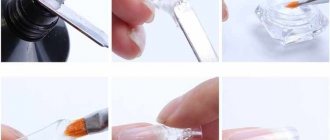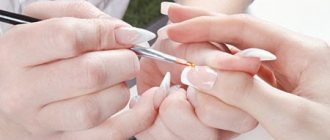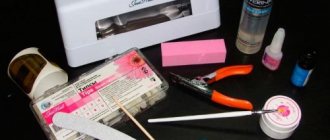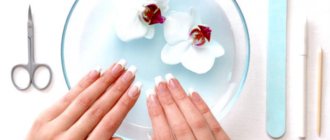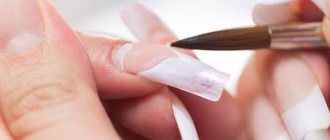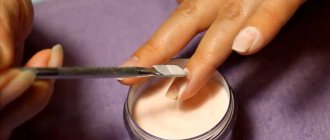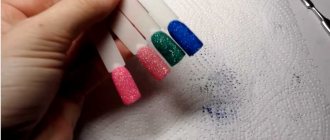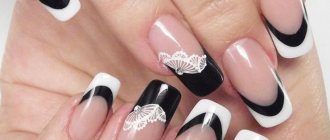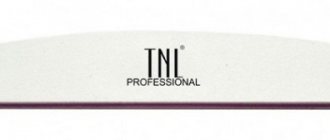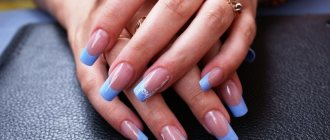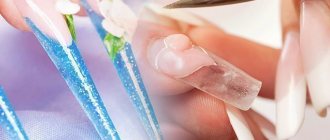Beauty technologies do not cease to develop rapidly, surprising the world with new products every year. Materials for decorating marigolds are becoming more and more convenient and reliable. For example, acrylic (also known as acrygel, polygel, combigel) is a new material that is finding more and more supporters among professional manicurists. You need to know when you hear the word polygel that this is a real salvation for nails.
Manicure with polygel
Nail care in the salon and at home
Before you go to the salon to get your nails beautifully decorated, you should make sure that they are healthy and well-groomed. Many procedures, despite the high level of safety, are still stressful for the nail plates.
Beautiful and strong nails will withstand any manipulation if you supply them with “building materials” in a timely manner, that is, the microelements necessary for growth. You can get them by eating healthy, organic foods, such as dairy products and fruits. Cereals, nuts, and vegetables are no less useful.
You should not constantly apply varnishes and do extensions; sometimes you need to give your nails a rest and treat them. Nourishing oils, baths of herbal decoctions or cosmetic wax are excellent helpers in healing.
To make your nails look attractive, you should devote enough time to a simple home manicure: remove overgrown edges in a timely manner, carefully file off any irregularities, and push back the cuticles. It is important to use disinfected, serviceable tools.
Important! You should not buy varnishes, as well as other materials for nail design, on the cheap. Doubtful compositions, predominantly made in China, are of low quality and can harm the nails.
How does the extension process work?
To do a good polygel nail extension, you must first prepare the ones in question and perform the following steps:
- The nail plates are prepared for processing and the usual forms are applied to them. At this stage it is possible to use a small amount of the base substance;
- It is necessary to moderately moisten the brush in the clinser, squeeze out a moderate amount of polygel from the tube and begin to rub it over the surface in an even layer. The thickness of the coating along the edges should be minimal, a little more is allowed in the center. If one portion of the material squeezed out of the tube initially is not enough, then you can add it as needed;
- After applying the polygel to the nails, they are dried under an ultraviolet lamp for about half a minute. All that remains is to remove the mold and make sawdust of the hardened mass.
A regular gel polish or topcoat is applied to the finished surface.
Polygel what is it
Polygel nail extension
Poly gel nails is a new technology that uses a composition that combines the properties of gel polish and acrylic. It is particularly reliable and stays on the nails until it is time to make a correction to hide the regrowth. At the same time, the polygel does not damage the nail plate, as happens when using acrylic.
Applying acrylic gel to the nail
The composition differs from gel polish in consistency: it is thick and does not spread when applied.
Acrylatic has a number of other important advantages:
- Does not have a pungent odor. You no longer have to open all the windows wide and suffer from the chemical “amber” that causes headaches. In addition, when working with polygel, you will not have to suffer from the ubiquitous dust. The composition is heavier than acrylic, and its particles settle almost immediately without floating in the air;
- With high strength, the polygel coating looks neat and natural, due to the fact that it is not applied in such thick layers as acrylic;
- The composition does not harden without drying under a UV lamp, which means there is no need to rush with modeling. You can add polygel to your nails until there is enough of it. In this case, unevenness will not appear, and the coating will be uniform;
- The use of a special liquid, a clinser, when working with acrylics makes the application process extremely simple. The composition does not spread, does not harden, lays down evenly and is well distributed with a brush;
- Since streaks are excluded, the skin around the nail will not suffer from the aggressive effects of the composition. This is especially important for girls prone to allergic reactions. Another plus for those with delicate hands is the absence of burning when drying under the lamp;
- After application, the coating almost does not need to be filed, especially since it can be easily removed using a router or file. This flexibility allows you to achieve the ideal shape;
- A thin layer of combigel does not weigh down the nails; high adhesive properties allow you not to worry about the integrity of the coating.
Perhaps the only disadvantage of polygel is the very small selection of colors. The palette of produced materials consists only of shades that are as close as possible to natural ones. If desired, you can apply a layer of bright gel polish on top of the coating, and an impressive manicure is ready.
Rating of the best funds
A detailed table will help the artist decide on the appropriate polygel for nail extensions. It contains the best modern means.
| Name | Peculiarities |
| Grattol | Texture – enamel, dense on 1-2 layers. On sale you can find 5 shade options at once. Among them: beige in different tones, camouflage, peach. There is an option with glitter. Sold in miniature packages of 30 ml. Very economical to use. After filing the material, it is recommended to sand the coating with buff (soft) to prevent the appearance of unsightly white spots |
| Bluesky | Texture: enamel. You can select different density levels. Coral and purple shades are also found in a wide color palette. The minimum volume of the tube is 8 ml. But you can also find 60 ml packages on sale. This polygel does not stick to the brush, so it does not require treating the accessory with a special liquid. This is one of the few such compositions that can be removed with gel polish remover. The composition has a special fine-grained structure that prevents the formation of small bubbles. |
| Tnl | The thermoplastic product is thick and very easy to work with. Available in 11 different shades. Texture: enamel. Density – translucent. With a sticky layer. Sold in 18 ml tubes. The coating needs to dry for 1 to 2 minutes, depending on the lamp chosen. To make working with the composition more convenient, you should use a reusable form for extensions. |
| Patrisa Nail | The texture of the composition is enamel. You can choose the density - translucent or dense composition. Various shades to choose from. There are also camouflage and beige in different tones. This is a high-quality, but expensive product. Sold in tubes ranging from 30 to 60 ml. |
| Tertio | Texture: enamel. The product is sold in 3 density options - translucent, dense in 3-4 layers, dense in 1-2 layers. Another inexpensive remedy. Sold in tubes of 30 ml. You can purchase different shades: white, camouflage, milky pink. The material is not picky about the bristles of brushes. It can be used when working with both natural and artificial accessories. |
All of the listed compositions differ from each other not only in their basic properties, but also in price. So, both budget and very high-quality options include, for example, Tnl, the cost of a tube is 350-400 rubles. But for a small tube of Patrisa Nail you will have to pay about 1 thousand rubles. Today, if you wish, you can grow your nails even at home.
The easiest and most convenient way is to use polygel for this purpose. This is a new unique product that combines all the positive features of both acrylic and gel. The main thing is that it does not have an unpleasant odor, and the particles that are cut off are heavy and quickly settle on the table without flying through the air. Step-by-step detailed instructions will help you understand the features of the process.
Article design: Oleg Lozinsky
How to use acrylic correctly
Nail correction
If we are talking about nail extensions, then you can work with both top forms and tips. The main thing to do is a regular clean manicure followed by dehydration. An acid-free primer is applied to the prepared nails.
Extensions on top forms with acrylic
How to extend short nails with polygel step by step:
- Forms are applied to the prepared nail plates. If necessary, apply a layer of base coat.
- The brush is moistened in a cleanser so that the bristles are damp, but not dripping.
- You need to take a little acrygel from the tube and put it on the nail using a spatula.
- Next, the composition is distributed over the plate in a thin layer. First, the brush moves towards the cuticle (there is no need to push acrylic under it), then towards the nail folds, and then towards the edge of the form. You need to carefully distribute the polygel, reducing it to almost zero at the edges.
- If there is not enough material, you can add more until you get a thin, neat layer that completely covers the mold.
- The nail is dried in a diode lamp for about 30 seconds. The mold is then removed and the nail is clamped to form an arch.
- A clip for extension is put on the plate, and the nail is dried again for half a minute under the lamp.
- A 140-240 grit file produces sawdust without applying too much pressure.
- The nail is treated with a buff for perfect smoothness.
- Finally, all that remains is to apply top coat or gel polish.
Strengthening nails
Strengthening your nails with Combigel is also not difficult; even a beginner who is starting to learn the basics of nail art can handle it.
How to strengthen nails with acrylic:
- A clean manicure is being performed. If necessary, wipe the marigolds with a dehydrator.
- You don’t need to apply the primer on dry nails; apply it in a very thin layer on wet nails.
- After a minute, it’s time to apply the base and dry the nails in the lamp.
- Moisten the brush in a special liquid, apply the composition to the nail as for extensions.
- Distribute acrygel to strengthen nails, starting from the cuticle and ending with the free edge of the plate. It is necessary to reduce the layer to almost zero. In this case, the excess that collects at the edge of the nail can be removed; if the composition does not stretch well, moisten the brush in the liquid.
- Having collected more clinser on the brush, the polygel layer is leveled, removing unnecessary roughness and unevenness.
- Dry the marigolds under a UV lamp. This will take 2 minutes.
- File off the excess using a 180-240 grit file and buff it.
- If a natural nude shade is suitable, you can apply a transparent top. Provided that the design should be bright, the nails are covered with gel polish.
Applying gel polish to polygel
Note! You can use any topcoat that is convenient to apply, or purchase a special base for polygel.
Nail repair with polygel
The procedure for repairing damaged natural nails is similar to the step-by-step instructions for strengthening them with polygel.
How to repair nails with acrylic gel:
- The first step, as always, is to tidy up your nails and clean them.
- A base is applied to the plates.
- Using a spatula, place an acrygel ball on the nails.
- The brush is slightly moistened with clinser.
- The polygel is distributed over the nail with gentle movements.
- The coating polymerizes under the lamp for 1.5 minutes.
- The shape is filed using a file (maximum 180 grit).
- Finally, a base is applied to the nails.
How to replace liquid for polygel
As a rule, a special construction fluid is used to work with polygel. No less often, a clinser is used for this purpose.
The liquid can be produced by any company; this does not affect compatibility with acrylic. There are times when the constructing composition is not at hand at all. Then you have to look for a replacement for a special liquid among household chemicals.
Liquid for working with acrylics
The simplest solution to the problem is to use regular alcohol. It is capable of softening the composition no worse than the constructive substance. However, professionals do not recommend replacing the original liquid with anything, because using third-party compounds can reduce the level of durability and ductility of acrygel.
In addition, alcohol will greatly dry out the skin around the nail, and with repeated use it will also damage the brush.
Varieties
Today, two types of upper forms are known. Depending on the cost, they can be either with or without markings to facilitate the work process. The first option is especially convenient for beginners who are getting acquainted with nail extensions using such templates.
The markings on the forms may differ; in some places they are arched stripes, in others they are a grid.
The set has the same arch and length, as well as markings with the indicated dimensions. Based on the marking lines, it is easier to align the length and adjust the edge. There is no need to tediously adjust an identical shape, since it already exists.
Read also: How to make an SSD a boot disk?
The upper forms are classified as reusable types of extension templates. They differ from arched counterparts and liquid tips.
Why doesn't acrylic stick to nails?
What is shellac in manicure
Polygel is a stable coating and problems rarely arise with it. However, errors in its use sometimes lead to peeling.
Partial loss of pigmentation and peeling are possible if the brush is wetted too much with a special liquid. There is no need to saturate the polygel with it, just soften it.
Acrylic does not spread, however, if you dry the finished coating for a short time, it will float. So it’s better to lay out the material, dry it according to the rules, and then admire the neat work.
To prevent air from getting into the material, it is advisable to work with small balls. You should not apply large portions of the composition, believing that this will speed up the work. On the contrary, the more polygel is applied, the more difficult it is to distribute it evenly.
What it is
Polygel is one of the innovative materials that combines the advantages of two types of modeling at once - acrylic and gel. The drug is gaining popularity among specialists and is ready to oppress many of its extension colleagues. But not everything is so simple: you need to choose a truly high-quality material so as not to cause even more harm to weakened and short nails.
Polygel is plastic, with it you can give your nail any shape. It does not have a specific unpleasant odor, unlike many other materials, and perfectly strengthens and heals the nail plate.
Manufacturers offer a wide range of polygels, but in this article we will talk exclusively about the best materials from well-known manufacturers.
How to remove polygel from nails
You can remove the coating using a 160-200 grit file or a manicure cutter. Soaking a persistent composition in any liquids is useless; in addition, it can easily damage your nails.
Acrylic Removal
Even a beginner can figure out how to use poly gel nails. The process of working with the material is simple, and the result will be better than when using other types of coating. Strengthening nails, repairing with polygel and extensions - with this composition everything is possible.
Maximum number of corrections allowed
The length of time your manicure will last depends on the rate of growth of the nail plate, as well as how you care for your hands. Most often, correction is carried out once every three to four weeks, but sometimes it has to be done more often. At the same time, it is useful to know how many times you can renew your manicure.
Read also: How to build a house in Minecraft
It all depends on the raw materials used to apply the manicure. For example, gel extensions allow you to do four to five repetitions. After this, the gel coating deteriorates and requires replacement or removal.
Polygel rating
When compiling the review, editorial specialists consulted with experienced nail technicians, who weeded out products of questionable quality. The rest were tested for plasticity, odor, and curing time. From the top you can choose cold transparent shining, camouflage and warm tones, and create a manicure according to your mood.
For beginners, it is better to start working with single-phase paste-like polymers. Professionals use two-three-phase camouflages of natural shades to lay out layers, where the first layer is responsible for adhesion, the second for the architecture of the nail plate; the third levels and creates a lens-shaped surface.
| Nomination | Place | Name | Price |
| Polygel rating | 1 | KINETICS Acrylic Gel | 1 850 ₽ |
| 2 | Vogue Nails PolyGel | 1 440 ₽ | |
| 3 | Patrisa Nail Kombi Gel | 805 ₽ | |
| 4 | Grattol Acryl Gel camouflage | 825 ₽ | |
| 5 | E.Mi Acrygel universal camouflage | 980 ₽ | |
| 6 | Lovely Nails Polygel | 1 190 ₽ | |
| 7 | Irisk Professional PolyGel | 775 ₽ | |
| 8 | TNL Professional Acryl Gel | 318 ₽ | |
| 9 | Kapous Shape Nail modeling camouflage | 682 ₽ |
KINETICS Acrylic Gel
Rating: 4.9
A plastic hybrid with a dense texture from the American brand combines the strength of acrylics and the transparency of gels. Suitable for modeling on liquid tips, upper forms for creating nails with the desired curve, prosthetics for peeling nails affected by fungus. Suitable as a strengthening layer for gel polish and indispensable for creating a laid-out French without a smile due to the creation of a clear boundary between the nail bed and the edge. Ideal for hiding imperfections on loose ends. When polymerized in a UV device from 36 Watts, it does not cause burning and will retain a pure shade. Sold in 60 ml packaging.
Advantages
- increased strength;
- no pungent odor:
- soft sawdust without dust;
- long-term retention of fluidity.
Flaws
- it is difficult to squeeze out the remains from the tube;
- individual intolerance to acrylate copolymer.
Vogue Nails PolyGel
Rating: 4.8
The construction product of the Russian-German brand Vogue Nails, which has been producing polygels since 2022, is suitable for professional modeling and strengthening of nails. In the line you can find shining white, light/dark pink, transparent in tubes of 20-60 ml. The viscous homogeneous mass is completely ready for work.
Thanks to its innovative formula, it is stronger, lighter and more flexible than acrylic. The composition retains its original texture at warm temperatures. The artist can immediately model all the nails without worrying about curling and deformation of the free edges. The material is ideal for nail architecture on the upper forms, creating volumetric and complex aquarium nail designs.
Advantages
- wide color palette of camouflage colors;
- strong adhesion to the nail plate prevents detachment;
- minimal consumption;
- different volumes of tubes;
- uniform texture;
- no need to apply a base to prime the nail plate.
Flaws
- White acrylates with a rich concentration of pigments take longer to dry.
Patrisa Nail Kombi Gel
Rating: 4.8
The German manufacturer Patrisa Nail produces high quality products that meet safety requirements. With the help of camouflage gel it is easy to increase moderate length without visible connecting lines, seal a crack, or correct a broken corner. On thin and fragile nail plates, a single-phase polymer forms a reinforcing layer that resists mechanical deformation. The natural shade hides the yellowness and traces of leukonychia – white stripes/spots, making the claws shape ideal. If a manicure in nude tones seems boring, make it matte, translucent or add shimmer.
Advantages
- simple application of the polymer composition;
- excellent adhesion;
- aesthetic appeal;
- masking defects;
- the ability to create three-dimensional designs;
- preventing the development of fungal diseases;
- absence of granular inclusions and air bubbles after polymerization;
- strength of artificial nails.
Flaws
- an allergic skin reaction to individual components is possible.
Grattol Acryl Gel camouflage
Rating: 4.7
Polygel with a thick texture is produced by a German brand in 30 ml tubes. The palette of 6 shades includes 4 camouflage, transparent, white tones. The color variety of acrylate copolymer allows the master to quickly select a range for each client.
The professional product is used in salons for nail architecture, laid-out French manicure with simultaneous extensions, giving the plate the desired shade, and repairing corners. The consistency fills uneven areas and acts as a primer base. Grattol Rubber Top is used for the finishing coat. It is recommended to apply it after sanding/filing with a soft buff. This will avoid sealing polymer dust after polymerization.
Advantages
- optimal consistency;
- easy molding of the free edge;
- well-groomed, smooth claws without grooves or inclusions;
- resistance to external damage and fungal diseases;
- strengthening the fragile nail plate.
Flaws
- high price.
E.Mi Acrygel universal camouflage
Rating: 4.6
The E.Mi brand produces a line of products for nail extensions and design. A viscous pink-beige gel-jelly is suitable for forming a free edge, laying out a jacket without cutting out a smile, or repairing a chipped edge without sealing the ends. Craftsmen use it instead of a base coat and as a finishing decorative layer with gloss. The formula contains medicinal components that prevent the development of fungus under manicure. Gel-jelly is suitable for beginners and professionals.
Advantages
- do not bubble after polymerization;
- guarantees adhesion to natural plastic and top layer;
- creates a durable elastic coating that requires minimal shape correction with a file;
- When cutting, it does not form fine polymer dust floating in the air.
- does not peel off in the cuticle area and on the tips.
Flaws
- high price;
- the need for correction once every 3 weeks;
- When the polymer coating is removed unprofessionally, the natural plate is damaged.
Lovely Nails Polygel
Rating: 4.5
Modeling/camouflaging hard combigel is suitable for increasing the length and forming a free edge, repairing natural nails. Especially recommended for those whose gel polish is peeling off. When used on thin, fragile nails, the manufacturer recommends applying camouflage to Soft Base Lovely.
Salon clients appreciate polygel for its lack of burning. At the same time, it functions as a color gel for design. The collection features 7 different shades, ranging from powdery, crystal-transparent and even dark beige. Polymerization time in a UV lamp: 120 seconds; in LED lamp: 60 sec.
Advantages
- low material consumption;
- natural color correction;
- masking transition lines;
- no odor or shrinkage;
- light drinking;
- maintaining gloss and color purity;
- volumes to choose from;
- easy removal of residues.
Flaws
- not noted.
Irisk Professional PolyGel
Rating: 4.4
The formula of a transparent gel of medium viscosity was developed by an American company. The product combines the properties of building gel and acrylic. It is stronger, lighter, more elastic than classical materials, and is suitable for modeling in upper and arched forms, on liquid tips. Strengthens weak nails, reconstructs those damaged by fungus. The structure of the polymer is similar to a natural plate, and after extension, the simulated claws do not differ from real ones. Copolymer
Advantages
- the copolymer fills unevenness and self-levels;
- the boundary line is not visible on the growing plate;
- allows air to pass through and does not disrupt tissue gas exchange;
- not susceptible to chipping due to mechanical damage;
- settling of heavy particles after sawdust eliminates the risk of allergies;
- cures under a lamp in 2 minutes.
Flaws
- there is a slight chemical smell.
TNL Professional Acryl Gel
Rating: 4.3
Jelly gels from the new color line of the Russian company were created in the laboratory of South Korea and Russia. Compositions based on urethane/polyester-acrylate oligomer combine the plasticity of a gel, the strength of acrylic and the ability to self-level. Thick viscous texture does not coagulate at high temperatures. This allows you to model the shape without haste, increase the length, strengthen fragile plates, restore defective areas, and do a French manicure. The line includes pink, milky white, peach, beige, lilac, smoky and dark shades with shimmer in 18 ml jars. There are a total of 23 shades in the collection.
Advantages
- forms an even transparent coating without using a base or monomer;
- does not crack when pressed;
- holds the arch well;
- guarantees mechanical strength;
- does not cause burning when drying;
- inexpensive.
Flaws
- designed for professionals.
Kapous Shape Nail modeling camouflage
Rating: 4.2
A new generation polyacrylic sculpting gel of medium viscosity was created for building up and masking defects in the nail plate. Thanks to its natural color and dense pigmentation, it is ideal for evening out color, lengthening the nail bed, and creating a French manicure. The plastic mass is laid out on a surface treated only with an acid-free primer and the architecture is modeled. Polygel allows you to control the process 100%, does not allow spreading and premature polymerization in a warm room. When layered, it covers the free edge line and maintains translucency in the cuticle area.
Advantages
- easy to display:
- self-levels upon application;
- easily models complex shapes such as arched;
- tightens up after 60 seconds;
- saves costs;
- safe for health.
Flaws
- not identified.
